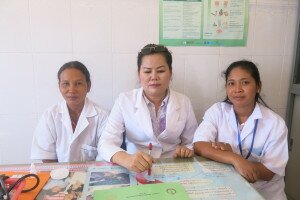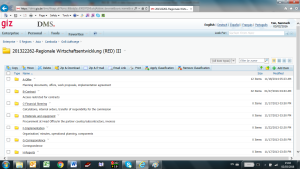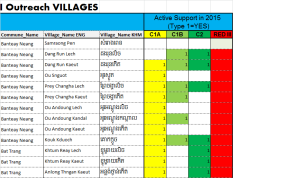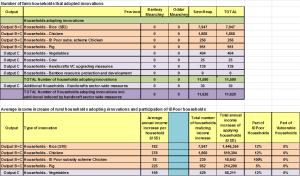Improving Midwifery Skills; a success story
Mrs Hout Phally is a 38-year-old midwife in the Hospital of Trapaing Kraloeung, Phnom Srouch operational District, Kampong Speu province. She felt insecure in some professional situations, and was often unsure about the correct course of action to take in medical emergencies as she lacked knowledge. Now, thanks to further professional training, Mrs. Hout Phally has improved her technical skills and recently applied these skills during a complicated delivery. More >>>
Improving Midwifery Skills; a success story
Mrs Hout Phally is a 38-year-old midwife in the Hospital of Trapaing Kraloeung, Phnom Srouch operational District, Kampong Speu province. She felt insecure in some professional situations, and was often unsure about the correct course of action to take in medical emergencies as she lacked knowledge. Now, thanks to further professional training, Mrs. Hout Phally has improved her technical skills and recently applied these skills during a complicated delivery.
Many midwives working in hospitals and health centers in Cambodia lack essential knowledge required to deliver high quality health services, resulting in inadequate treatment for mothers and newborns. To improve delivery, postpartum and newborn care, the Royal Government of Cambodia initiated ‘The Fast Track Initiative Road Map for Reducing Maternal and Newborn Mortality for 2010-2015’. Through the Maternal and Newborn care project, GIZ has backed Cambodia’s efforts to reduce maternal and neonatal mortality by among others providing training and capacity building for hospitals and health centers in Kampong Speu, Kampot, Kep and Kampong Thom.
The GIZ project provides funds and technical support to the Provincial Health Department (PHD) to enhance capacity of midwives at Emergency Obstetric and Newborn Care (EmONC) facilities. A particular focus is the capacity to perform the seven signal functions[i] of EmONC. The program aims to reduce the main causes of death for mothers and newborns, including management of postpartum hemorrhage. To bring these interventions into practice, the project supports quarterly meetings of the Midwifery Coordination Alliance Team (MCAT)[ii] with health center and referral hospital midwives. In addition, continuous supervision, necessary equipment, training courses for midwives, and coaching are provided in the coverage area.
In 2015, the project supported training courses on Basic Emergency Obstetric and Newborn Care (BEmONC) for midwives and doctors working in health centers and referral hospitals. The project covered around 90% of EmONC staff in 24 EmONC facilities across 12 operational health districts and 4 provinces. This achievement saved numerous women’s lives in the coverage areas.
The benefits of the programme are described by Ms. Hout Phally. She had a patient called Ms. Bou Sokha, a 24 year old woman, who was pregnant for the first time. She came to Trapaing Kroloeung Hospital accompanied by her husband and father one evening in May 2015. At midnight, Ms. Sokha was felt she was in labor but her delivery did not progress as the membrane did not rupture naturally. The midwives considered transferring Ms. Sokha to the provincial hospital while examining her condition every few hours. Transfer was not necessary as in the early morning the membrane ruptured. Ms. Sokha was in constant pain between contractions.
 Ms. Sokha’s delivery was attended by Ms. Phally and her colleagues Ms. Sao Ry and Ms. Prum Khen. During Ms. Sokha’s delivery the midwives identified signs of complications and decided to use the vacuum extractor to assist the delivery. The skills required for this procedure had recently been taught at an MCAT meeting. After the delivery, the midwives treated a second complication, a retained placenta, by manually removing the placenta. Later, Ms. Phally identified extensive bleeding in her patient, suggesting the entire placenta had not come away. Here, a second set of skills taught at the MCAT meetings was applied to care for this seriously hemorrhaging patient. The midwives administered oxytocin 10 IU and massaged Ms. Sokha’s uterus. Eventually the bleeding ceased and Ms. Sokha’s condition returned to normal. The midwives monitored her condition for a further 2 hours. Ms. Phally also advised Ms. Sokha to start early initiate breastfeeding, put her baby on skin to the skin and return back. Thus, their actions during this delivery saved Ms. Sokha’s life.
Ms. Sokha’s delivery was attended by Ms. Phally and her colleagues Ms. Sao Ry and Ms. Prum Khen. During Ms. Sokha’s delivery the midwives identified signs of complications and decided to use the vacuum extractor to assist the delivery. The skills required for this procedure had recently been taught at an MCAT meeting. After the delivery, the midwives treated a second complication, a retained placenta, by manually removing the placenta. Later, Ms. Phally identified extensive bleeding in her patient, suggesting the entire placenta had not come away. Here, a second set of skills taught at the MCAT meetings was applied to care for this seriously hemorrhaging patient. The midwives administered oxytocin 10 IU and massaged Ms. Sokha’s uterus. Eventually the bleeding ceased and Ms. Sokha’s condition returned to normal. The midwives monitored her condition for a further 2 hours. Ms. Phally also advised Ms. Sokha to start early initiate breastfeeding, put her baby on skin to the skin and return back. Thus, their actions during this delivery saved Ms. Sokha’s life.
Ms. Phally finds the MCAT useful for acquiring new knowledge, best practices and exchanging experience among health center and referral hospital staff. She appreciates the support of GIZ, the opportunity to participate in MCAT meetings, and attendance on a BEmONC course, which improved both her knowledge and working methods. Ms. Phally strongly desires the GIZ-Maternal and Newborn care project’s continued support of these activities in order to improve quality of delivery by trained health workers. The trainings and the support of MCAT meetings led not only to improvements in individuals but also to systematic improvements.
[i] BEmONC (1)Administration of parenteral antibiotics, (2)Administration of parenteral oxytocic drugs (3) Severe pre-eclampsia/eclampsia management and MgSo4 Administration of parenteral anticonvulsants, (4) Manual removal of placenta, (5)Removal of retained products, (6) Assisted vaginal delivery (vacuum extraction) and (7) Newborn resuscitation by using a bag and mask. CEmONC is 7 in BEmONC plus Caesarian section and Blood Bank
[ii] MCAT is organized every quarter at OD level. OD MCH and/or Referral Hospital midwife review results of supportive supervision at health centers, focusing on what problem areas can be improved, why the problems. occurred, how to solve them, and creating an action plan
![]()
DMS Makes RED III Progress and Impact Monitoring Easy
2 March 2016
The Regional Economic Development Program III (RED III) is a Cambodian rural development program supported by Gesellschaft für Internationale Zusammenarbeit (GIZ) and the Swiss Agency for Development and Cooperation (SDC). The program is scheduled to last from September 2014 to December 2017. It succeeds the GIZ-supported Regional Economic Development Program – Green Belt that was implemented in the province of Siem Reap from October 2007 until August 2014. More>>>
DMS Makes RED III Progress and Impact Monitoring Easy
2 March 2016
The Regional Economic Development Program III (RED III) is a Cambodian rural development program supported by Gesellschaft für Internationale Zusammenarbeit (GIZ) and the Swiss Agency for Development and Cooperation (SDC). The program is scheduled to last from September 2014 to December 2017. It succeeds the GIZ-supported Regional Economic Development Program – Green Belt that was implemented in the province of Siem Reap from October 2007 until August 2014.
The program aims to support the poor, rural population – especially women – in using new, sustainable business and employment opportunities
and employment opportunities to increase their income
to increase their income and reduce poverty. Since January 2015, RED III is active in three provinces: Siem Reap, Banteay Meanchey and Oddar Meanchey. The program promotes four fields of activities (1) Local government action for inclusive growth, (2) Stakeholder cooperation for local economic development, (3) Sustainable services and business links for increased competitiveness of local products and (4) Knowledge partnership with national level stakeholders.
and reduce poverty. Since January 2015, RED III is active in three provinces: Siem Reap, Banteay Meanchey and Oddar Meanchey. The program promotes four fields of activities (1) Local government action for inclusive growth, (2) Stakeholder cooperation for local economic development, (3) Sustainable services and business links for increased competitiveness of local products and (4) Knowledge partnership with national level stakeholders.
With the expansion of the program to two additional provinces with their own offices, three components, and a vast range of different stakeholders involved in implementing program activities, managing program data can become challenging. The program has adopted the GIZ Document Management System (DMS) as the centerpiece for data collection, modification and storage which integrates this variety of data generating sources.
The DMS functions as a cloud computing device across GIZ which helps store and organize relevant corporate information regarding projects or programs around the globe, including instruments and tools, regulations and strategies, reports and experiences etc. Information can be accessed, edited, and changed by authorized DMS users (usually GIZ personnel) by using ‘Open’ and ‘Edit’ functions which are controlled by Microsoft Office programs (Word, Excel and PowerPoint) using an ActiveX control that is normally installed the first time when the DMS is called up. Users can also download documents. In case the ‘Open’ and ‘Edit’ functions do not work due to the automatic installation is blocked by the Internet Explorer security settings, the software Office-Editor “OFFICEEDITOR_CLIENT” needs to be downloaded and manually installed.
In the context of RED III, for the purpose of storing and monitoring documents, the DMS is used in the following way:
On the GIZ website (https://www.giz.de), there is a link, through which you can access and log on to the intranet including DMS (https://dms.giz.de). On the DMS overview page, there is a main selection menu from which you can navigate your way to your own projects or programs. For RED III in particular, you need to go through ‘Enterprise’, ‘Region’, ‘Asia’, ‘Cambodia’, ‘GnB Auftraege’, and ‘201322262-Regionale Wirtschaftsentwicklung (RED) III’. Since the program has a mandatory standard structure of established folders, RED III created a new folder for Monitoring and Evaluation (M&E) working documents. This separate folder helps to keep working documents apart from finalized documents, which are stored in the standardized folders mentioned above. This way, work-in-progress can easily be accessed, edited, changed without risking a mix-up of finished and unfinished products. Staff members can further create sub-folders under the new folder and add (upload) documents or data files as required.
(https://www.giz.de), there is a link, through which you can access and log on to the intranet including DMS (https://dms.giz.de). On the DMS overview page, there is a main selection menu from which you can navigate your way to your own projects or programs. For RED III in particular, you need to go through ‘Enterprise’, ‘Region’, ‘Asia’, ‘Cambodia’, ‘GnB Auftraege’, and ‘201322262-Regionale Wirtschaftsentwicklung (RED) III’. Since the program has a mandatory standard structure of established folders, RED III created a new folder for Monitoring and Evaluation (M&E) working documents. This separate folder helps to keep working documents apart from finalized documents, which are stored in the standardized folders mentioned above. This way, work-in-progress can easily be accessed, edited, changed without risking a mix-up of finished and unfinished products. Staff members can further create sub-folders under the new folder and add (upload) documents or data files as required.
In this regard, an M&E technical staff member of the program created several forms for data entry using Microsoft Excel and uploaded them onto DMS. These forms serve the purpose of monitoring implementation progress (milestones and activities) of the annual operational plan, spatial coverage (villages, communes, and districts), household outreach and impacts of the program. The following pictures show some parts of the forms.
After these forms had been uploaded onto DMS, all program technical staff members involved in entering data were informed and trained on how to use them. The training, which is conducted and repeated in the framework of short workshops, always includes an introduction to DMS, how to navigate through the data files, enter data or edit the data files on the DMS and finally on how to make sure that the updated data files are properly saved and synchronized.
The M&E technical staff member follows up and backstops all types of data entries regularly and ensures that deadlines for updating data on DMS are met. When necessary, he provides technical training on advanced Microsoft Excel functions used in data entries, summary, and visualization.
In the context of the RED III program, the use of DMS is the most efficient way to collect and manage data from different provinces and components. Storing data in only one authorized repository does not only safeguard data integrity but also ensures that summaries, analyses and reports generated from the data are consistent. Moreover, the DMS supports transparency and data quality for it is open to all staff to point out wrong or inconsistent data and make the necessary corrections.
For further information, please contact:
Dr Wolfram Jaeckel, RED III Program Leader | , Or
Mr Samrach Ten, RED III Planning, Monitoring and Evaluation Advisor |
![]()






